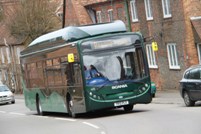
Completion of the order for 20 vehicles, made in August 2012, is scheduled for completion by early May
The UK’s first Scania-ADL gasfuelled buses, part of an order of 20 for Reading Buses, have now been delivered and an official handover ceremony was held in Reading on Monday, April 22, where the first vehicles were on display. Completion of the order is scheduled for early May, with the new fleet being progressively introduced into service shortly thereafter.
Reading Buses CEO James Freeman said: “When we ordered these vehicles last August, we were continuing our long history of innovation whereby we have consistently sought to operate at the leading edge, both in terms of efficiency and with regard to environmental standards. The combination of stylish, proven, British-built bodywork with technology promising high performance, minimal running costs and a carbon-neutral fuel solution, ticks all of the boxes for us.
“Furthermore, we have a long track record of successful partnerships with both Scania and ADL and go into this initiative with the knowledge of the aftermarket support they offer. Additionally, the new gas vehicles will share a large number of common components with the 100-plus Scania vehicles already in our bus fleet.”
Scania’s Bus, Coach and Engine Sales Director Tony Tomsett added: “We are delighted the UK’s first Scania-powered gas buses will soon be in service with Reading Buses. This project has been a collaborative effort between ourselves, ADL and the Gas Bus Alliance and I would like to thank all concerned for all the hard work put in to ensure the success of this ground-breaking venture. Everyone has pulled together to ensure these buses could be built and achieve all the necessary compliance in time to meet the start date of Reading’s contract.”
The vehicles will operate on a variety of services in and around the Reading area, including a major contract serving Green Park, Madjeski Stadium and Kennet Island. Based on 12-metre Scania KUB 4×2 chassis, the vehicles are powered by Scania’s OG9 GO4 gas engine, a 270 horsepower EEV 9.3-litre five-cylinder energy efficient lean burn unit capable of operating on either Compressed Natural Gas (CNG) or Bio Natural Gas (BNG). The engine offers high efficiency and low fuel consumption with no need for exhaust gas recirculation (EGR). It is based on the same platform as Scania’s modular-build 9.3-litre diesel engine, which limits the number of new components required for the low entry gas chassis to around 40 items.
The vehicles feature single-deck 40-seat Enviro E300SG bodywork, designed and engineered by ADL, Scania’s gas bus development partner. The Gas Bus Alliance will provide infrastructure and fuel supply to Reading Buses.
Initial fuelling of the vehicles is being carried out from supplies of gas tankered onto the site. James Freeman though it would be around three months before a mains-fed gas installation could be finished and commissioned.
Scania has produced gas-fuelled vehicles for almost 100 years. An early example being buses adapted to run on producer gas during the First World War years. It produced dedicated gas bus engines in 1940. In recent times Scania has supplied in excess of 3,800 gas engines for various applications in a number of countries worldwide. These include fleets operating in the Swedish municipalities of Uppsala, Malmö and Helsingborg as well as vehicles in Madrid and Brisbane.


